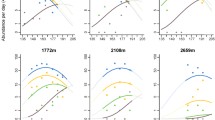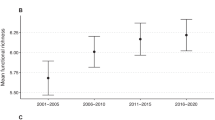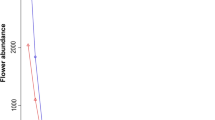Abstract
Primary successions of glacier forelands are unique model systems to investigate community dynamics and assembly processes. However, successional changes of plant and insect communities have been mainly analysed separately. Therefore, changes in plant–insect interactions along successional gradients on glacier forelands remain unknown, despite their relevance to ecosystem functioning. This study assessed how successional changes of the vegetation influenced the composition of the flower-visiting insect assemblages of two plant species, Leucanthemopsis alpina (L.) Heyw. and Saxifraga bryoides L., selected as the only two insect-pollinated species occurring along the whole succession. In addition, we investigated the links between reproductive output of these plants and pollinator abundance through experimental exclusion of pollinators. Plant community structure changed along the succession, affecting the distribution and the abundance of insects via idiosyncratic responses of different insect functional groups. L. alpina interacted with ubiquitously distributed pollinators, while S. bryoides pollinators were positively associated with insect-pollinated plant species density and S. bryoides abundance. With succession proceeding, insect assemblages became more functionally diverse, with the abundance of parasitoids, predators and opportunists positively related to an increase in plant cover and diversity. The reproductive output of both plant species varied among successional stages. Contrary to our expectation, the obligate insect-pollinated L. alpina showed a reproductive output rather independent from pollinator abundance, while the reproductive output of the self-fertile S. bryoides seemed linked to pollinator abundance. Observing ecological interactions and using functional traits, we provided a mechanistic understanding of community assembly processes along a successional gradient. Plant community diversity and cover likely influenced insect community assembly through bottom-up effects. In turn, pollinators regulate plant reproductive output through top-down control. We emphasise that dynamics of alpine plant and insect communities may be structured by biotic interactions and feedback processes, rather than only be influenced by harsh abiotic conditions and stochastic events.



Similar content being viewed by others
References
Aeschimann D, Lauber K, Moser DM, Theurillat J-P (2004) Flora alpina. Zanichelli Editore, Bologna
Albrecht M, Riesen M, Schmid B (2010) Plant-pollinator network assembly along the chronosequence of a glacier foreland. Oikos 119:1610–1624
Albrecht M, Schmid B, Hautier Y, Müller CB (2012) Diverse pollinator communities enhance plant reproductive success. Proc R Soc B 279:4845–4852
Caccianiga M, Andreis C, Cerabolini B (2001) Vegetation and environmental factors during primary succession on glacier forelands: some outlines from the Italian Alps. Plant Biosyst 135:295–310
Caccianiga M, Luzzaro A, Pierce S, Ceriani RM, Cerabolini B (2006) The functional basis of primary succession resolved by CSR classification. Oikos 112:10–20
de Jong YSDM (2013) Fauna Europaea version 2.6. http://faunaeur.org
Devoto M, Medan D, Montaldo H (2005) Patterns of interaction between plants and pollinators along an environmental gradient. Oikos 109:461–472
Elberling H, Olesen JM (1999) The structure of high latitude plant-flower visitor system: the dominance of flies. Ecography 22:314–323
Erschbamer B, Mayer R (2011) Can successional species groups be discriminated based on their life history traits? A study from a glacier foreland in the Central Alps. Plant Ecol Divers 4:341–351
Erschbamer B, Kneringer E, Niederfringer Schlag R (2001) Seed rain, soil seed bank, seedling recruitment, and survival of seedlings on a glacier foreland in the Central Alps. Flora 196:304–312
Erschbamer B, Niederfringer Schlag R, Winkler E (2008) Colonization processes on a central Alpine glacier foreland. J Veg Sci 19:855–862
Foster BL, Tilman D (2000) Dynamic and static view of succession: testing the descriptive power of the chronosequence approach. Plant Ecol 146:1–10
Gibson RH, Knott B, Eberlein T, Memmott J (2011) Sampling method influences the structure of plant-pollinator networks. Oikos 120:822–831
Gobbi M, Latella L (2011) La fauna dei prati -1: tassonomia, ecologia e metodi di studio dei principali gruppi di invertebrati terrestri italiani. Quaderni del Museo delle Scienze, Trento
Gobbi M, De Bernardi F, Pelfini M, Rossaro B, Brandmayr P (2006) Epigean arthropod succession along a 154 year glacier foreland chronosequence in the Forni Valley (Central Italian Alps). Arct Antarct Alp Res 38:357–362
Gobbi M, Rossaro B, Vater A, De Bernardi F, Pelfini M, Brandmayr P (2007) Environmental features influencing Carabid beetle (Coleoptera) assemblages along a recently deglaciated area in the Alpine region. Ecol Entomol 32:682–689
Gobbi M, Caccianiga M, Cerabolini B, Luzzaro A, De Bernardi F (2010) Plant adaptive response during primary succession are associated with functional adaptations in ground beetles on deglaciated terrain. Community Ecol 11:223–231
Gregor F, Rozkošny R, Barták M, Vaňhara J (2002) The Muscidae (Diptera) of Central Europe. Folia Fac Sci Nat Univ Masaryk Brun 107:1–280
Hegland SJ, Boeke L (2006) Relationships between the density and diversity of floral resources and flower visitor activity in a temperate grassland community. Ecol Entomol 31:532–538
Hegland SJ, Totland O (2012) Interactions for pollinator visitation and their consequences for reproduction in a plant community. Acta Oecol 43:95–103
Hodkinson ID, Coulson SJ, Harrison J, Webb NR (2001) What a wonderful web they weave: spiders, nutrient capture and early ecosystem development in the high Arctic—some counter-intuitive ideas on community assembly. Oikos 95:349–352
Hodkinson ID, Coulson SJ, Webb NR (2003) Community assembly along proglacial chronosequence in the high Arctic: vegetation and soil development in north-west Svalbard. J Ecol 91:651–663
Jedlička L, Kúdela M, Stloukalová V (2009) Checklist of Diptera of the Czech Republic and Slovakia. Electronic version 2. http://zoology.fns.uniba.sk/diptera2009
Jones CC, del Moral R (2009) Dispersal and establishment both limit colonization during primary succession on a glacier foreland. Plant Ecol 204:217–230
Jongman RHG, ter Braak CJF, van Tongeren OFR (1995) Data analysis in community and landscape ecology. Cambridge University Press, Cambridge
Kaufmann R (2001) Invertebrate succession on an Alpine glacier foreland. Ecology 82:2261–2278
König T, Kaufmann R, Scheu S (2011) The formation of terrestrial food webs in glacier foreland: evidence for the pivotal role of decomposer prey and intraguild predation. Pedobiol 54:147–152
Ladinig U, Wagner J (2007) Timing of sexual reproduction and reproductive success in the high-mountain plant Saxifraga bryoides L. Plant Biol 9:683–693
Lázaro A, Jakobsson A, Totland Ø (2013) How do pollinator visitation rate and seed set relate to species’ floral traits and community context? Oecologia 173:881–893
Lázaro A, Lundgren R, Totland Ø (2014) Experimental reduction of pollinator visitation modifies plant–interactions for pollination. Oikos 123:1037–1048
Legendre P, Legendre L (2012) Numerical ecology. Elsevier, Amsterdam
Losapio G, Jordán F, Caccianiga M, Gobbi M (2015) Structure-dynamic relationship of plant–insect networks along a primary succession gradient on a glacier foreland. Ecol Model 314:73–79
Matthews JA (1992) The ecology of recently-deglaciated terrain: a geoecological approach to glacier forelands and primary succession. Cambridge University Press, Cambridge
Mellini E (1997) From predation to parasitoidism in the Diptera order. Boll Ist Entomol Guido Grandi Uni Bologna 51:91–159
Molau U (1993) Relationship between flowering phenology and life history strategies in tundra plants. Arct Antarct Alp Res 25:391–402
Nielsen A, Steffan-Dewenter I, Westphal C et al (2011) Assessing bee species richness in two Mediterranean communities: importance of habitat type and sampling techniques. Ecol Res 26:969–983
Oksanen J, Blanchet FG, Kindt R et al (2014) Vegan: community ecology package. R package version 2.2-1. http://CRAN.R-project.org/package=vegan
Oosterbroek P (2006) The European families of Diptera: identification, diagnosis, biology. KNNV Publishing, Utrecht
Pignatti S (1982) Flora d’Italia. Edagricole, Bologna
Potts SG, Vulliamy B, Dafni A, Ne’eman G, Willmer P (2003) Linking bees and flowers: how do floral communities structure pollinator communities? Ecology 84:2628–2642
R Core Team (2014) R: a language and environment for statistical computing. Ro Foundation for Statistical Computing, Vienna
Raffl C, Marcante S, Erschbamer B (2007) The role of spontaneous selfing in the pioneer species Saxifraga aizoides. Flora 202:128–132
Raso L, Sint D, Mayer R, Plangg S, Recheis R, Kaufmann R, Traugott M (2014) Intraguild predation in pioneer predator communities of Alpine glacier forelands. Mol Ecol 23:3744–3754
Scherber C, Eisenhauer N, Weisser WW et al (2010) Bottom-up effects of plant diversity on multitrophic interactions in a biodiversity experiment. Nature 468:553–556
Speight MCD (2013) Species accounts of European Syrphidae (Diptera), 2013. Syrph the net, the database of European Syrphidae. Syrph the Net publications, Dublin
ter Braak CJF (1986) Canonical correspondence analysis: a new eigenvector technique for multivariate direct gradient analysis. Vegetatio 69:69–77
Thernau T (2014) A package for survival analysis in S. R package version 2.37-7. http://CRAN.R-project.org/package=survival
Totland Ø (2003) Breeding system, insect flower visitation, and floral traits of two alpine Cerastium species in Norway. Arct Antarct Alp Res 35:242–247
Vater AE, Matthews JA (2013) Testing the ‘addition and persistence model’ of invertebrate succession in a subalpine glacier-foreland chronosequence: Fåbergstølsbreen, southern Norway. Holocene 23:1151–1162
Walker LR, Wardle DA, Bardgett RD, Clarkson BD (2010) The use of chronosequence in studies of ecological succession and soil development. J Ecol 98:725–736
Wirth LR, Waser NM, Graf R et al (2011) Effects of floral neighbourhood on seed set and degree of outbreeding in a high-alpine cushion plant. Oecologia 167:427–434
Acknowledgments
We thank the Adamello-Brenta Natural Park for providing sampling permission and logistic support. All applicable national guidelines for the care and use of animals were followed. CS was supported by the Swiss National Science Foundation (PZ00P3_148261). The research project was co-financed by Autonomous Province of Trento (Italy). All authors disclose any potential sources of conflict of interest.
Author information
Authors and Affiliations
Corresponding author
Additional information
Handling Editor: Heikki Hokkanen.
Gianalberto Losapio, Mauro Gobbi, Giuseppe Marano and Marco Caccianiga have equally contributed to this work.
Electronic supplementary material
Below is the link to the electronic supplementary material.
Rights and permissions
About this article
Cite this article
Losapio, G., Gobbi, M., Marano, G. et al. Feedback effects between plant and flower-visiting insect communities along a primary succession gradient. Arthropod-Plant Interactions 10, 485–495 (2016). https://doi.org/10.1007/s11829-016-9444-x
Received:
Accepted:
Published:
Issue Date:
DOI: https://doi.org/10.1007/s11829-016-9444-x




